
Previous posts have focused on the rocket that is the center column for our orrery. The one pictured here doesn't have the bottom section with the fins, but our new one does. Now that the rocket has been carved and the holes bored into it to accept the drive tubes, it can be put aside for a bit and we move on to the next section - The arms.
You can see here that each planet has its own arm. The rocket is cut into little sections so that each arm will spin freely on a bearing between the rocket sections. So it's time to craft the arms. While the arms are being built, the planets can also be blown. If we have some good weather, we'll get going on that too.Back to the arms. They need to be very strong - the piece is going into a college, where no doubt, there will be drunken college students attempting to take Jupiter home with them. A lot of thought and design has gone into this orrery to make it "Student-Proof", as best we can anyway... Since they're pretty thin, we've chosen to make the arms out of carbon fiber (what they make jet fighters out of, and the new SpaceShip One) It's extremely sturdy, and very lightweight. Lightweight matters because the planets themselves, being blown glass, are going to be on the heavy side and we want to make sure all that weight off of one side of the rocket doesn't screw up its ability to spin freely, so wherever we can make something lighter, it's a good thing.
But how do we make an arm from this mystical "Carbon Fiber"? We can get CF in various forms from online stores that sell to homemade airplane makers, or car hobbyists. It comes in rod, tube, tape or a fabric. Hmmm.... Fabric.... I used to work professionally as a costume designer for theatres, and have worked with fabric all my life. I could use my fabric knowledge with this new technique! How hard could it be?
You can see here, the feather spars I built for our mobile projects. The longest is about 16 feet long! The largest is about 4 inches wide by 3/4 inch thick at the tube. Only about an 1/8 inch thick on the feather.Now here is a closeup of those feather spars before I did the final trim work on them. You can see that it is a cross weave fabric. It's a very thick fabric, and the weave is loose so it tends to wiggle all over the place. It is also highly toxic, so gloves, goggles and a mask are required. I first make a long pattern of what the full piece needs to be and then carefully cut the CF to match.
The feather shape is laid out on plastic in a specially designed mold that will hold it in its "feather" shape until it's set. It is wrapped around a central tube, which gives it stability and also a way for us to pass the wiring needed for each planet, and then soaked with a two part epoxy glue. The plastic is then rolled over the top, sealing the piece inside. I then squeegee out the excess glue and smooth it under the plastic so that there aren't any bubbles or dry spots. I add weights to hold it in the tight curve shape. Then it's just a matter of waiting for the epoxy to set up. I check on it often during the next 12 hours to make sure nothing is coming loose or slipping.
I will use this same technique for the orrery arms, but on a smaller scale. The longest arm is only 3 feet long, with a gentle curve to it, and fairly thin - it will be under 3/8 inch thick. I plan on squeezing the pieces towards the inner part of the curve to that when I trim and clean it up, it won't be as visible as it would be on the outside where people are seeing it more.That's the plan. We'll see how it goes! How hard could it be?
Peace,
Joy
Short URL for this post: //spherical.org/s/q

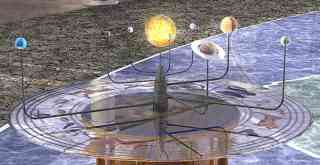
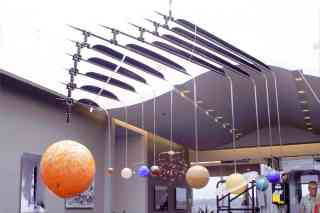
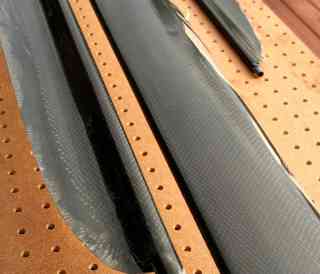

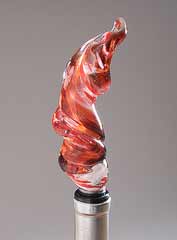
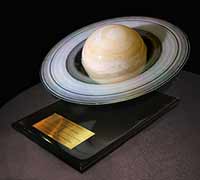
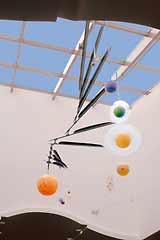


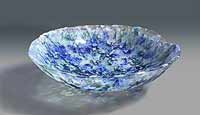
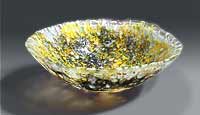

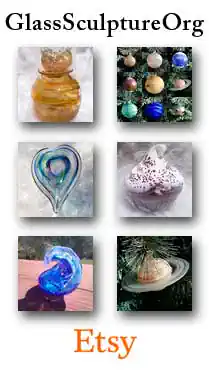
March 8th, 2009 at 1:06 pm
This is a fabulous piece! Congratulations on such an interesting design and thanks for explaining the process (i.e. each arm will spin freely on a bearing between the rocket sections). Good luck on making it student-proof!
I also love the feather spars on the mobile. Very interesting selection for the piece.
March 8th, 2009 at 5:01 pm
Thank you!! Yes, I hope it is strong enough. It isn't going into a hugely public area, so hopefully it will remain intact and safe.
I'm glad you found the explanations useful. I am so deep into it, I don't know what I'm taking for granted or not. Please ask questions if something is unclear.
The feathers for the mobile were a cool idea. We needed something that would grab a little available air current and move the arms. Feathers seemed appropriate. Since the orrery is motor driven, it doesn't need anything like that, so the arms will be just round.
On the mobiles, we can adjust the angle of the feathers while we're installing it best point at the doors or vents, so the whole mobile will get the best airflow possible. Very cool to see it work!
Peace,
Joy